Key takeaways:
- Fusion cuisine creatively blends diverse culinary traditions, encouraging experimentation while respecting individual flavors.
- Successful fusion relies on thoughtful integration of bold ingredients and presentation, often telling a story between cultures.
- Popular fusion examples include unique combinations like ceviche sushi rolls and masala pizza, showcasing the harmony between different cuisines.
- Techniques such as sous vide and deconstruction can elevate fusion dishes, enhancing flavors and transforming familiar meals.
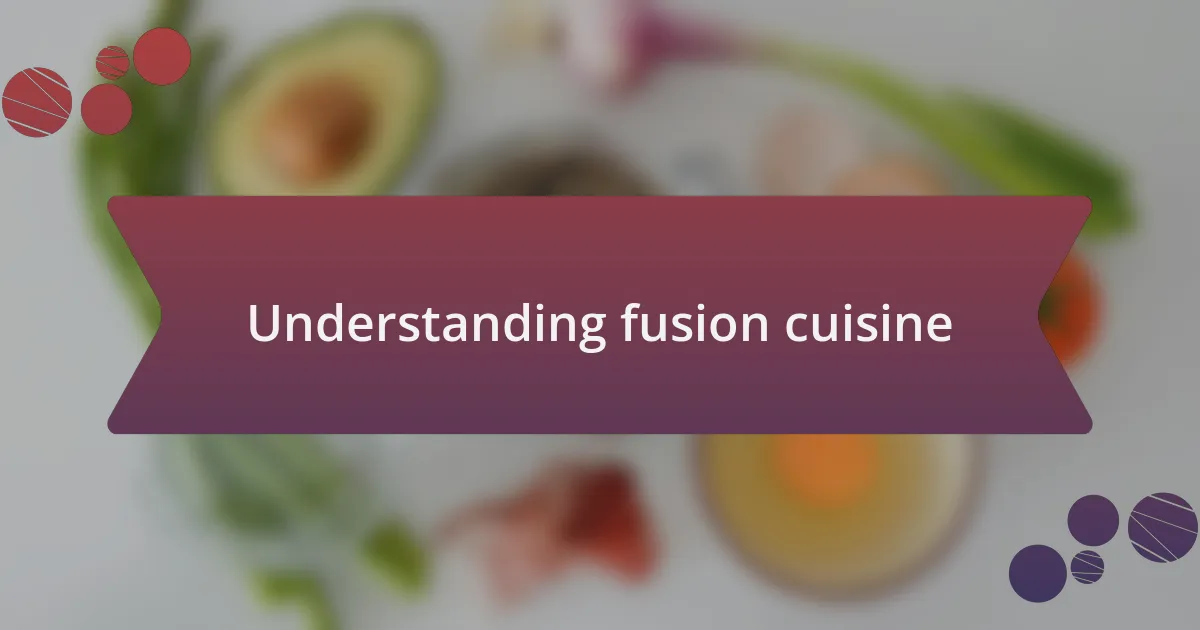
Understanding fusion cuisine
Fusion cuisine represents a beautiful marriage of flavors and cultures, creating dishes that often surprise and delight the palate. I remember the first time I tried a Korean barbecue taco—it’s a memory that still makes my mouth water. How could such diverse culinary traditions come together so seamlessly? This approach not only showcases unique flavor combinations but also reflects our increasingly interconnected world.
At its core, fusion cuisine encourages creativity, prompting cooks to explore beyond the boundaries of traditional recipes. I often find myself contemplating what happens when I blend spices from one culture with techniques from another. It invites experimentation while honoring the origins of each element, resulting in something entirely new that celebrates both culinary heritages.
However, there’s a delicate balance in fusion cooking that one must consider. While it’s tempting to throw together disparate ingredients, successful fusion relies on a thoughtful integration of flavors. Have you ever tasted a dish that seemed too chaotic? Those flops remind us that respect for the individual character of each cuisine is crucial to achieving harmony on the plate.
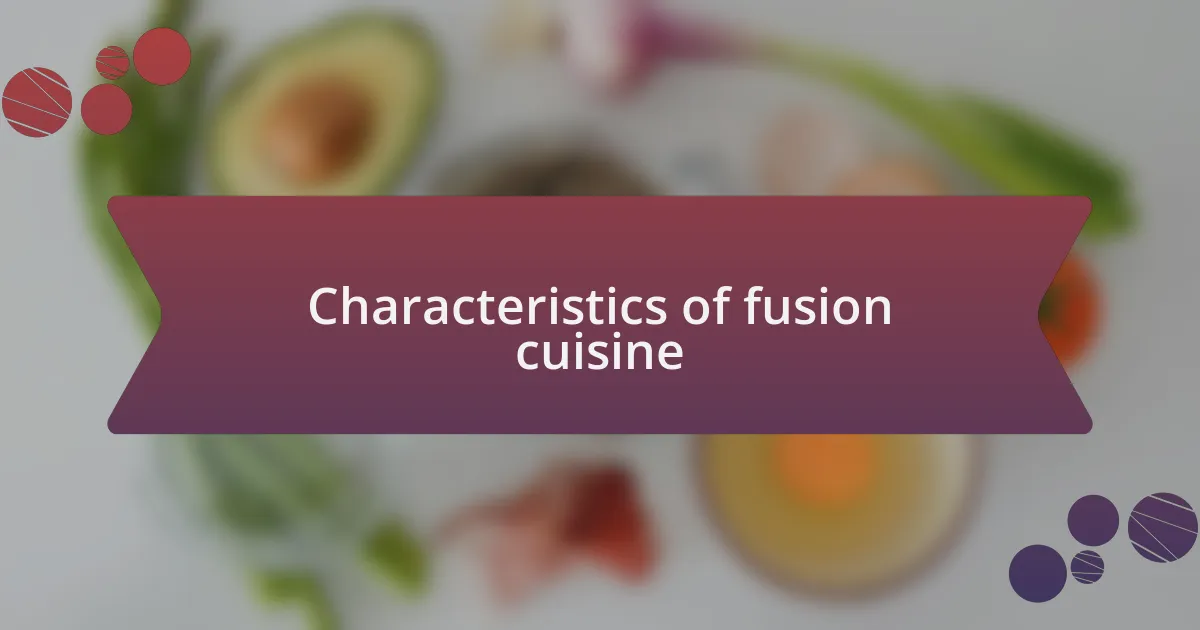
Characteristics of fusion cuisine
When I think about fusion cuisine, one characteristic that stands out is its boldness in flavor pairing. I still recall the time I tried a Thai basil pesto pasta; the unexpected combination had a freshness and kick that caught me off guard. How is it that ingredients from such different culinary traditions can coexist on one plate, creating an entirely new experience? This adventurous spirit is what makes fusion cuisine so exciting and memorable.
Another hallmark of fusion cuisine is the emphasis on presentation. I’ve noticed that many fusion dishes not only taste amazing but also look incredible. Imagine a sushi burrito, artfully wrapped and showcasing vibrant colors! It’s a feast for the eyes as much as it is for the taste buds. The artistry involved reflects a deeper appreciation for the culinary craft, inviting diners to savor not just the flavors but the visual experience as well.
Finally, I find that fusion cuisine often tells a story, revealing a connection between cultures through food. For instance, when I indulged in a kimchi quesadilla, it sparked a conversation about the blending of Mexican and Korean traditions. Isn’t it fascinating how food can bridge gaps and foster understanding across diverse backgrounds? This narrative aspect adds another layer to the dining experience, making each bite resonate on a more personal level.
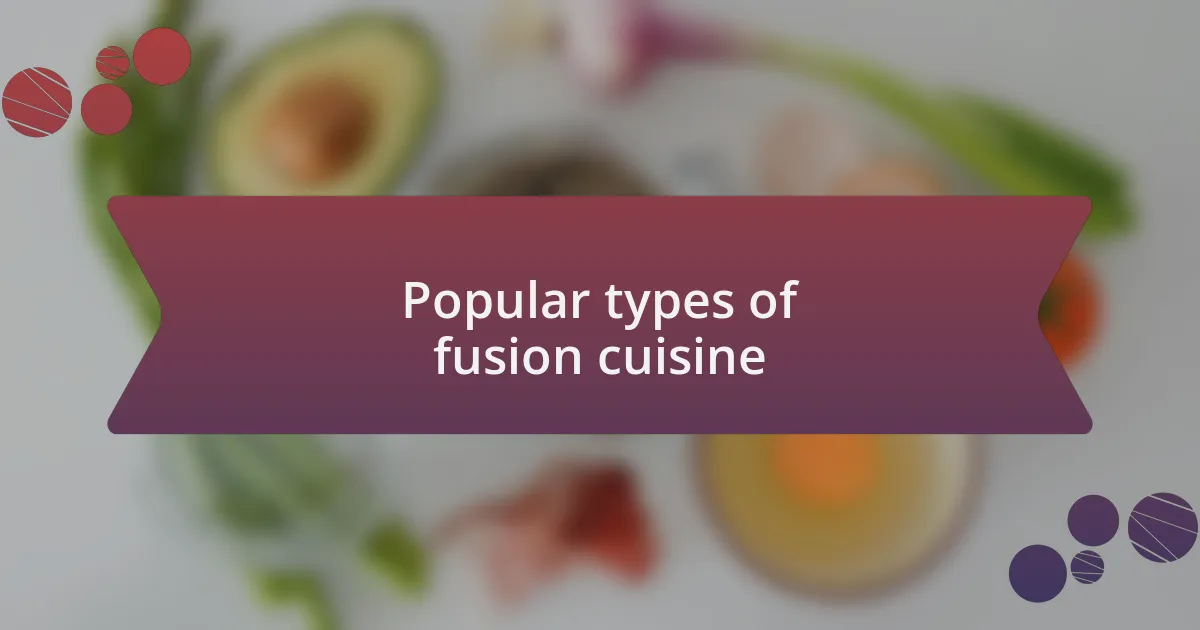
Popular types of fusion cuisine
When I think about popular types of fusion cuisine, one that always comes to mind is the merging of Japanese and South American flavors. The first time I experienced a ceviche sushi roll, I was mind-blown. How could such contrasting components come together so harmoniously? The bright, zesty flavors of the ceviche perfectly complemented the delicate sushi rice, creating a dance of taste that felt both familiar and brand new.
Another fascinating fusion takes place between Indian and Italian dishes. I remember savoring a masala pizza that was topped with a spicy tomato sauce, fresh cilantro, and a sprinkle of paneer. Each bite was like a mini celebration, filled with the warmth of spices and the comfort of classic pizza. Isn’t it incredible how two seemingly different culinary worlds can unite to produce something entirely unique?
Then there’s the great American fusion, where traditional comfort food meets international influences. A standout for me was a bulgogi burger, where the sweet-tender Korean beef met a classic American bun. It made me wonder, why stick to one cuisine when we can explore a world of combinations? This type of fusion not only satisfies my cravings but also sparks creativity in the kitchen, encouraging me to experiment with ingredients I’ve never paired before.
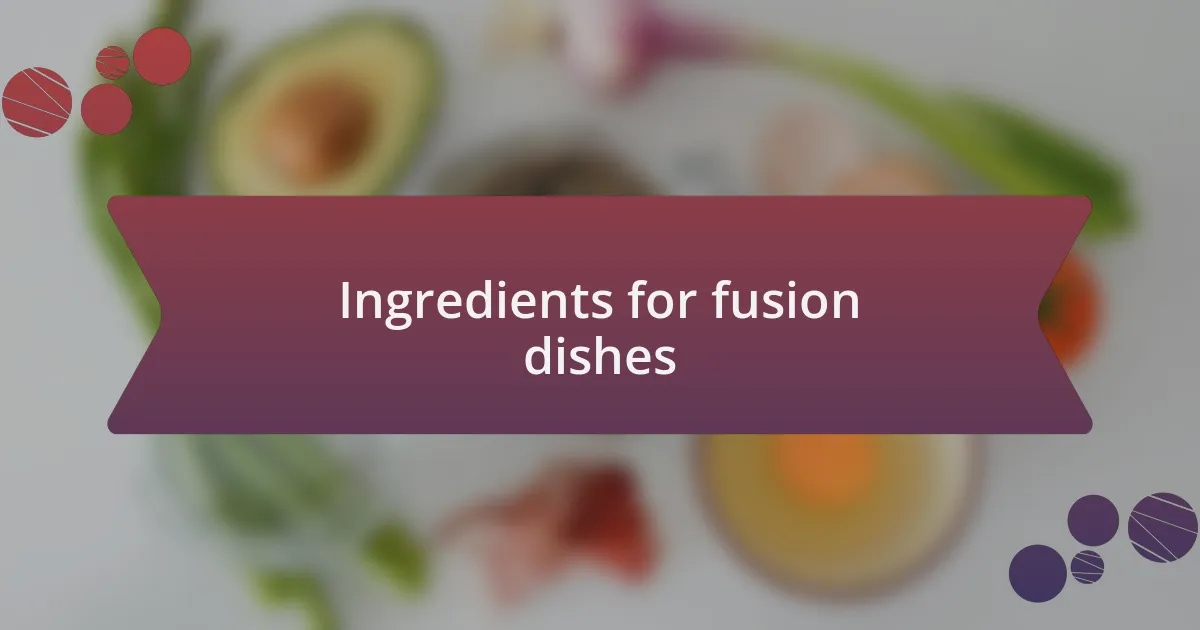
Ingredients for fusion dishes
When it comes to crafting fusion dishes, the choice of ingredients is pivotal. I recall a time when I experimented with a Thai curry risotto, using Arborio rice and coconut milk infused with lemongrass. As the creamy risotto absorbed the aromatic flavors, I couldn’t help but marvel at how one staple ingredient could take on such diverse culinary roles. Have you ever thought about how the adaptability of certain ingredients can transcend cultural boundaries?
Another exciting aspect of fusion cuisine is the use of spices. I once blended Mexican chipotle with Italian balsamic glaze to create a vibrant marinade for grilled vegetables. The smoky heat of the chipotle intertwined beautifully with the sweetness of the glaze, electrifying my taste buds with each bite. It’s fascinating to see how the right balance of spices can elevate a dish from ordinary to extraordinary. What combination have you discovered that surprised you?
Lastly, the inclusion of unexpected vegetables can truly transform a fusion dish. During one of my cooking sessions, I added roasted kimchi to a classic mac and cheese recipe. The tangy flavor of the kimchi provided a delightful contrast to the creamy cheese, completely changing my perception of a comfort classic. Isn’t it amazing how a simple ingredient swap can lead to a whole new culinary adventure?
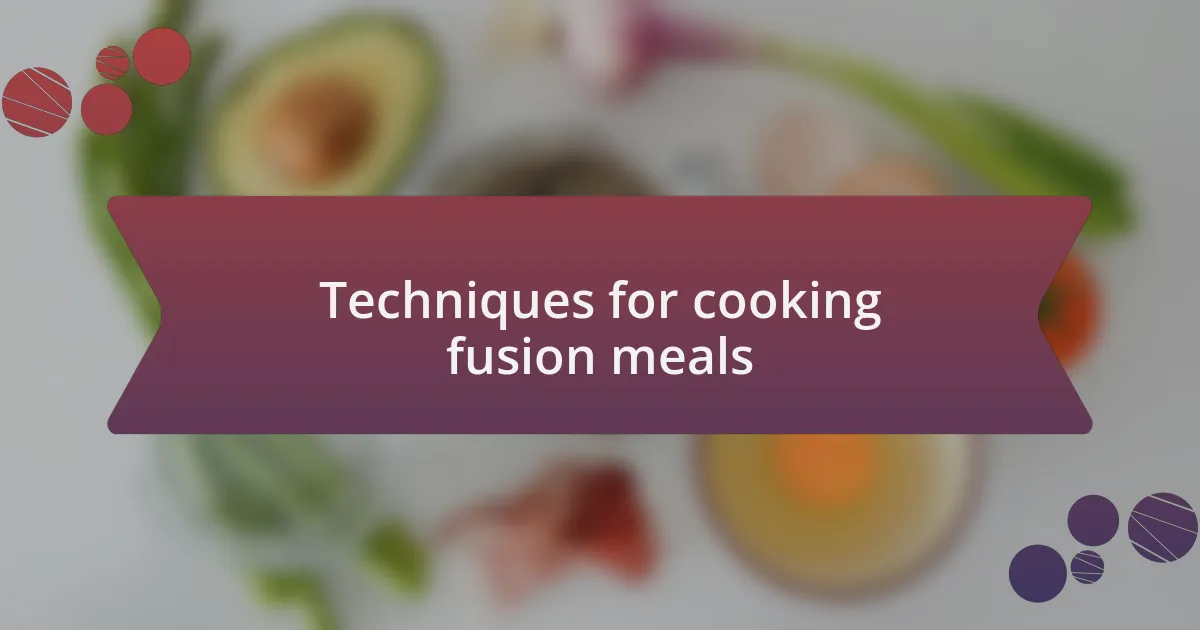
Techniques for cooking fusion meals
Cooking fusion meals often calls for innovative techniques that go beyond traditional methods. I remember once using a sous vide method to prepare a pork belly dish that combined Japanese teriyaki flavors with a classic French confit technique. The result was a melt-in-your-mouth texture infused with rich, sweet flavors, and it made me wonder: have you considered how precise temperature control can enhance bold tastes in fusion cooking?
Another approach I’ve found effective is deconstruction. This involves breaking down classic dishes and presenting them in a new light, which can lead to surprising flavor profiles. For instance, I took a traditional Indian butter chicken curry and transformed it into a deconstructed version by separating the elements: tender chicken bites sit atop a bed of spiced jasmine rice, drizzled with a yogurt sauce and garnished with fresh cilantro. This technique opens up a dialogue between the components, allowing each flavor to shine through. Ever tried serving a familiar dish in a truly unexpected way?
Lastly, mastering various cooking methods can significantly expand your fusion repertoire. I once paired stir-frying with slow-cooking to create a beef stew that was both tender and richly flavored. The quick sear locked in juices, while the slow-cooked elements developed deep, comforting flavors that brought together influences from both Asian and Western cuisines. It got me thinking: how might blending these techniques change the way you approach your own culinary creations?
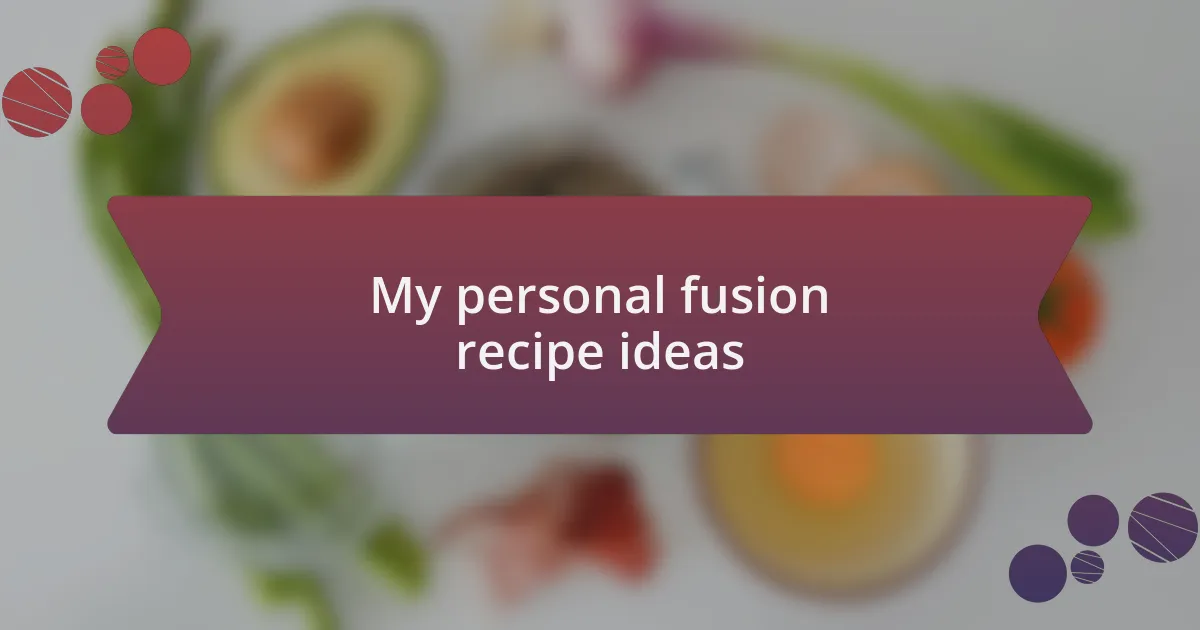
My personal fusion recipe ideas
One fusion recipe I love is my take on a traditional taco, inspired by Asian flavors. I fill soft corn tortillas with grilled marinated chicken in a ginger-soy sauce, topped with a crunchy Asian slaw made from cabbage, carrots, and a drizzle of sesame dressing. It’s a vibrant combination that transports my taste buds to another world, and I often find myself questioning how something so simple can give such complex satisfaction.
Another delightful creation emerged when I combined classic Italian risotto with fragrant Thai curry. As the creamy rice cooked slowly, I added coconut milk, lemongrass, and Kaffir lime leaves, which transformed the dish into a fragrant symphony of flavors. The first time I served it, the look on my friends’ faces was priceless, as they wondered how a familiar dish could feel so incredibly exotic and comforting at the same time!
One night, I decided to create a sushi-inspired poke bowl with a twist, replacing traditional rice with flavorful quinoa. I topped it with fresh cubed salmon, avocado, and a tangy mango salsa that added a wonderful sweetness. It was a moment filled with joy as I watched my family enjoy a healthy meal that was bursting with colors and flavors, making me think: how can a simple change in ingredients lead to something that feels completely new and exciting?
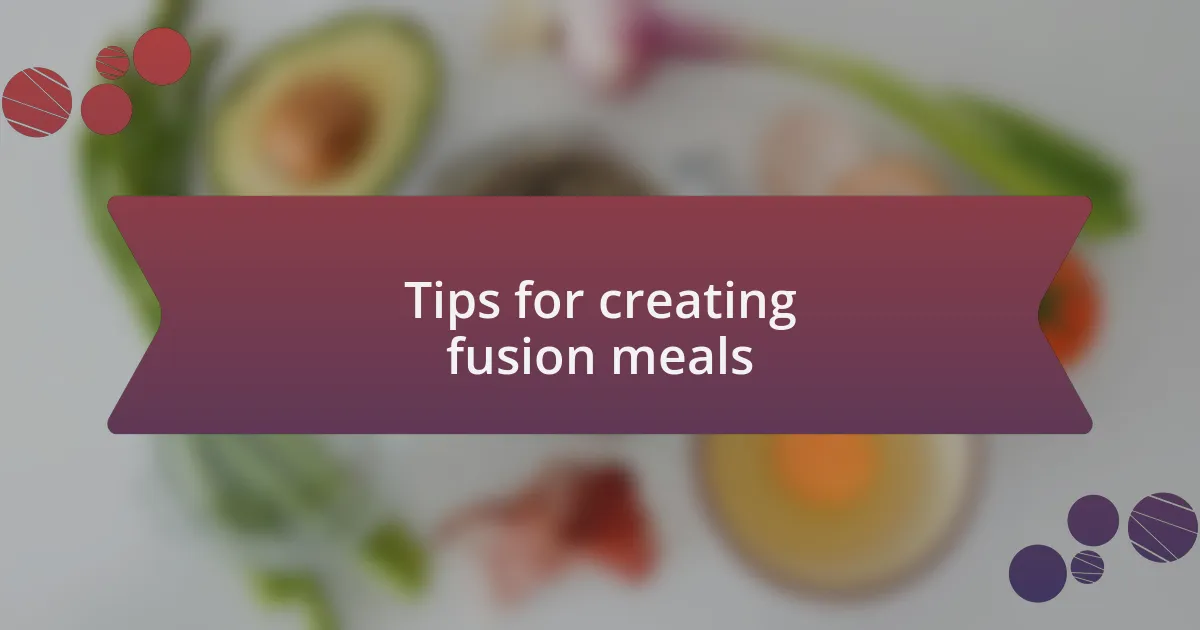
Tips for creating fusion meals
When creating fusion meals, I often start by selecting two cultures whose flavors intrigue me. Recently, I tried combining Korean barbecue with traditional Mediterranean elements, like a bulgogi gyro. The savory sweetness of the marinated beef paired beautifully with creamy tzatziki—I couldn’t believe how the bold flavors complemented each other.
One crucial tip is to focus on balance. The goal is to harmonize flavors rather than overpowering one with the other. I remember the first time I added a spicy kimchi to a rich, creamy pasta dish. Instead of clashing, the heat elevated the entire meal, making it memorable. Have you ever experienced a dish where one ingredient took it to the next level?
Don’t shy away from experimenting with cooking techniques, too. For instance, grilling vegetables gives them a smoky depth that can elevate a seemingly simple stir-fry. I learned this while trying out a Mediterranean stir-fry with grilled zucchini and bell peppers—who knew a little char could bring so much life to a dish? Fusion is all about play; embrace that creativity!